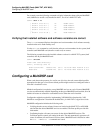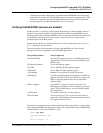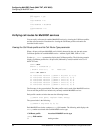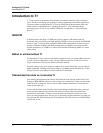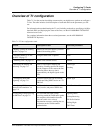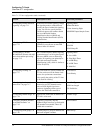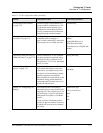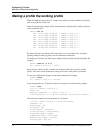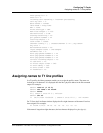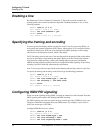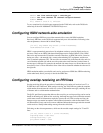
7-2 Preliminary May 9, 2000 APX 8000/MAX TNT/DSLTNT Physical Interface Configuration Guide
Configuring T1 Cards
Introduction to T1
Introduction to T1
A T1 line consists of 24 channels. Each channel can transmit and receive data or digitized
voice. The line uses framing and signaling to achieve synchronous and reliable transmission.
The most common configurations for T1 lines are ISDN Primary Rate Interface (PRI) and
nailed (leased) or unchannelized T1, including fractional T1. (For information about
provisioning your T1 line for use with the TAOS unit, see Appendix A, “Provisioning the
Switch.”)
ISDN PRI
In North America and Japan, a T1/PRI line typically supports 23 B channels and one
D channel. But if non-facility associated signaling (NFAS) is in use, more than one ISDN PRI
line on a single T1 card can share a single D channel. PRI configurations are used to receive
multiple, simultaneous ISDN calls from analog-modem and digital-services dial-in traffic.
Another common use of T1/PRI is to connect a Private Branch Exchange (PBX) to a central
office switch.
Nailed or unchannelized T1
Unchannelized T1 lines can be used for nailed connections such as to a Frame Relay network.
In such cases the configuration is static, and the TAOS unit treats the T1 line as if it were a
single connection at a fixed speed, without individual channels.
Typically, when you pay your telephone company for a leased (nailed) line, you pay more for
higher bandwidth. Anything in the range of 0bps to 1.544Mbps can be delivered on a T1 line,
and provisioned at some 64Kbps fraction of the full T1 bandwidth.
Channelized line-side vs. trunk-side T1
Calls entering the telephone network from the TAOS unit must enter the central office (CO)
through an ISDN PRI line. However, calls coming in on a channelized T1 line can enter either
on the line side or trunk side. For best results, ensure that the channelized T1 calls enter the
switch on the trunk side.
T1 lines that terminate on the line side of the switch undergo an additional analog-to-digital
conversion that reduces the data transfer rate. Some service providers and carriers have
agreements to ensure that a T1 always enters the trunk side of the CO switch, but in most
cases, no such agreement exists. The only way to guarantee a digital connection is to make sure
that calls from the TAOS unit enter the CO on the trunk side of the switch over an ISDN PRI or
a trunk-side T1 line.



